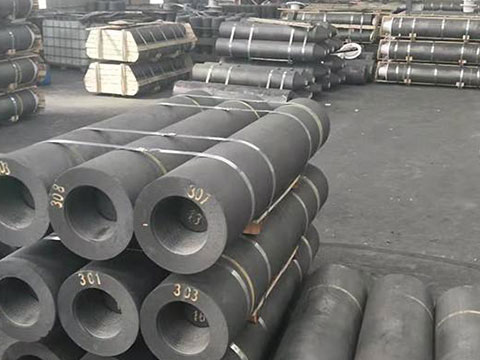The graphite electrode consumption in electric furnaces is generally considered to be the third largest in the cost of molten steel after scrap steel and electrical energy. In Europe, the consumption range is 3 to 7 kg / t (crude steel). This article will analyze the main reasons for the differences in electrode consumption of various electric furnaces. It is also pointed out that when the influence of graphite electrode properties is small, the operating conditions of the furnace are the main factors for the change in electrode consumption.

Electric Arc Furnaces use electrical energy as the main energy source. Electric energy draws arcs through graphite electrode and charge discharge. Produce high temperatures up to 2000 ~ 6000 ℃. The scrap material is melted by means of arc radiation, temperature convection and heat conduction. In the configuration of graphite electrodes for steel-making electric arc furnaces, the basic principles of “ordinary power electric furnace with ordinary power graphite electrode, high power electric furnace with high power graphite electrode, and ultra high power electric furnace with ultra high power graphite electrode” should be followed .
Arc furnace electrodes, especially graphite electrode that connected by nipple joints, and can effectively prevent the electrodes from breaking during use. Electric arc furnaces are electric furnaces that use high temperatures produced by electrode arcs to smelt ores and metals. The energy is very concentrated when the gas discharge forms an arc, and the temperature in the arc zone is above 3000 ° C. For smelting metals, the electric arc furnace has greater process flexibility than other steel-making furnaces, can effectively remove impurities such as sulfur and phosphorus, the furnace temperature is easy to control, and the equipment occupies a small area.
Calculation Method of Graphite Electrode Consumption
The graphite electrode is the last part of the short-circuit power supply of the electric arc furnace. The end of the graphite electrode generates a strong arc to melt the charge and heat the molten steel, that is, the electrode is the central hub that converts electrical energy into thermal energy. The electrode is subjected to high temperature, furnace gas oxidation and colliding material impact during operation. In particular, the junction of the two electrodes has a higher resistance and lower conductivity than other places. Easy to trip, oxidize, fall off and break. As a result, the electrode is greatly consumed, and the smelting time is extended, and the productivity is reduced.
In 1982, Bowman divided the normal graphite electrode consumption into front end consumption and side consumption. Both can be calculated using the following formula:
Normal Graphite Electrode Consumption: CE = Cγ + Cs
Front-End Consumption: Cγ = Vγ · TOntap / W, Vγ = Kγ · I2 / dnγ
In the formula,
TOntap — electric furnace power transmission time, h;
W — Electric furnace tapping weight, t;
Vγ — consumption speed of electrode front end, kg / h;
Kγ-front-end consumption constant (Bowman gives Kγ = 0.0361 for AC arc furnace and n usually takes 0.58)
I ———— Arc current intensity, kA;
dγ ——— The diameter of the electrode front end, m.
Side Consumption: Cs = Vs · TTop-Top / W, Vs = 3Ks · S
In the formula,
TTop-Top — Electric furnace smelting period, h;
W — Electric furnace tapping weight, t;
Vs — consumption speed of electrode side, kg / h;
Ks — oxidation consumption rate, kg / (m2 · h);
S — oxidized surface area in the electrode furnace, m2.
At present, in the production process, the Bowman graphite electrode consumption model has been widely recognized. Wang Mingli and others believe that once the smelting process is stable, the current supplied by the power supply has the greatest impact on the electrode unit consumption.
It is generally believed that in the smelting process, the calculation of graphite electrode consumption has two concepts, net consumption and gross consumption. Net consumption refers to the technical consumption of electrodes consumed during high-temperature sublimation, oxidation and participation in smelting. Gross consumption is the sum of the net consumption and the losses that have not been participated in the smelting. In other words, the graphite electrode consumption model mentioned above is only technical consumption, that is, it is classified as net consumption. Gao Zhanbiao and others believe that at this stage the steel industry mainly uses the following two methods to calculate graphite electrode consumption.
(1) Production method
The output method is based on the amount of molten steel (finished product) produced in a certain period, and the amount of graphite electrode input during the same period minus the remaining amount on the furnace is consumed.
Gross Loss of Tons of Graphite Electrode: MM = MZ / MG
Net Consumption of Ton Steel Graphite Electrode: MJ = MC / MG
In the formula,
MZ—the total consumption of the electrode (input amount-remaining amount on the furnace), kg / t;
MC—The pure consumption of the electrode (input amount-remaining amount on the furnace-loss amount), kg / t;
MG-the amount of finished molten steel, t.
(2) Power consumption method.
The power consumption method is based on the cumulative power consumption of pure heating time in a certain period. The amount of graphite electrode input during the same period deducts the remaining amount on the furnace as the consumption (LF furnace is calculated based on the power consumption and electrode for each temperature increase of 1 ℃).
Graphite Electrode Consumption per Kilowatt Hour: MX = 1000 × MC / QH
In the formula,
MC-the pure consumption of the electrode (input amount-residual amount on the furnace-loss amount), kg / t;
QH ——— The cumulative power consumption in pure heating time, kW · h.
At this stage, when calculating the graphite electrode loss, steel companies generally include the amount that is lost without participating in the smelting. This can more fully reflect the center of gravity and key points of loss in the steelmaking process of the electric arc furnace. So as to find the shortcomings in the process parameters to solve.
